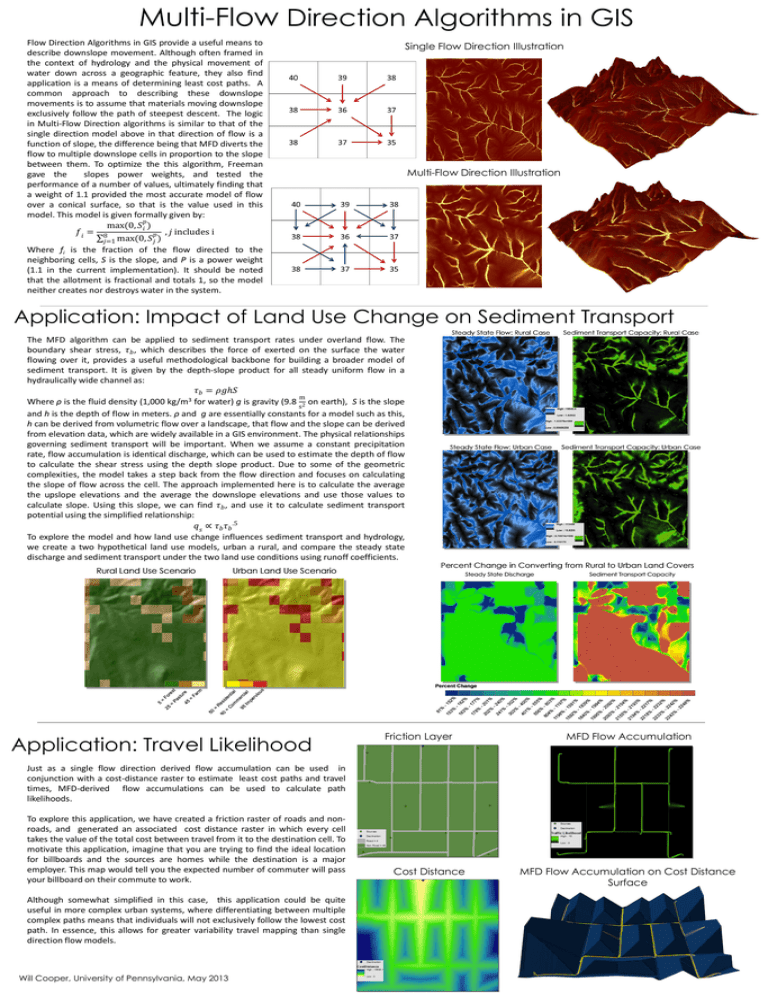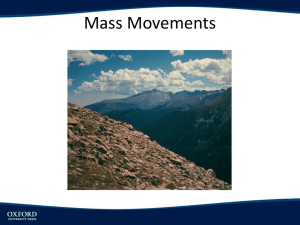Multi-Flow Direction Algorithms in GIS
advertisement

Multi-Flow Direction Algorithms in GIS Flow Direction Algorithms in GIS provide a useful means to describe downslope movement. Although often framed in the context of hydrology and the physical movement of water down across a geographic feature, they also find application is a means of determining least cost paths. A common approach to describing these downslope movements is to assume that materials moving downslope exclusively follow the path of steepest descent. The logic in Multi-Flow Direction algorithms is similar to that of the single direction model above in that direction of flow is a function of slope, the difference being that MFD diverts the flow to multiple downslope cells in proportion to the slope between them. To optimize the this algorithm, Freeman gave the slopes power weights, and tested the performance of a number of values, ultimately finding that a weight of 1.1 provided the most accurate model of flow over a conical surface, so that is the value used in this model. This model is given formally given by: 𝑝 max(0, 𝑆𝑖 ) 𝑓𝑖 = 8 𝑝 , 𝑗 includes i 𝑗=1 max(0, 𝑆𝑗 ) Where fi is the fraction of the flow directed to the neighboring cells, S is the slope, and P is a power weight (1.1 in the current implementation). It should be noted that the allotment is fractional and totals 1, so the model neither creates nor destroys water in the system. Single Flow Direction Illustration Multi-Flow Direction Illustration Application: Impact of Land Use Change on Sediment Transport The MFD algorithm can be applied to sediment transport rates under overland flow. The boundary shear stress, 𝜏𝑏 , which describes the force of exerted on the surface the water flowing over it, provides a useful methodological backbone for building a broader model of sediment transport. It is given by the depth-slope product for all steady uniform flow in a hydraulically wide channel as: 𝜏𝑏 = 𝜌𝑔ℎ𝑆 m Where ρ is the fluid density (1,000 kg/m3 for water) g is gravity (9.8 s2 on earth), S is the slope and h is the depth of flow in meters. ρ and g are essentially constants for a model such as this, h can be derived from volumetric flow over a landscape, that flow and the slope can be derived from elevation data, which are widely available in a GIS environment. The physical relationships governing sediment transport will be important. When we assume a constant precipitation rate, flow accumulation is identical discharge, which can be used to estimate the depth of flow to calculate the shear stress using the depth slope product. Due to some of the geometric complexities, the model takes a step back from the flow direction and focuses on calculating the slope of flow across the cell. The approach implemented here is to calculate the average the upslope elevations and the average the downslope elevations and use those values to calculate slope. Using this slope, we can find 𝜏𝑏 , and use it to calculate sediment transport potential using the simplified relationship: 𝑞𝑠 ∝ 𝜏𝑏 𝜏𝑏 .5 To explore the model and how land use change influences sediment transport and hydrology, we create a two hypothetical land use models, urban a rural, and compare the steady state discharge and sediment transport under the two land use conditions using runoff coefficients. Application: Travel Likelihood Friction Layer MFD Flow Accumulation Just as a single flow direction derived flow accumulation can be used in conjunction with a cost-distance raster to estimate least cost paths and travel times, MFD-derived flow accumulations can be used to calculate path likelihoods. To explore this application, we have created a friction raster of roads and nonroads, and generated an associated cost distance raster in which every cell takes the value of the total cost between travel from it to the destination cell. To motivate this application, imagine that you are trying to find the ideal location for billboards and the sources are homes while the destination is a major employer. This map would tell you the expected number of commuter will pass your billboard on their commute to work. Although somewhat simplified in this case, this application could be quite useful in more complex urban systems, where differentiating between multiple complex paths means that individuals will not exclusively follow the lowest cost path. In essence, this allows for greater variability travel mapping than single direction flow models. Will Cooper, University of Pennsylvania, May 2013 Cost Distance MFD Flow Accumulation on Cost Distance Surface



